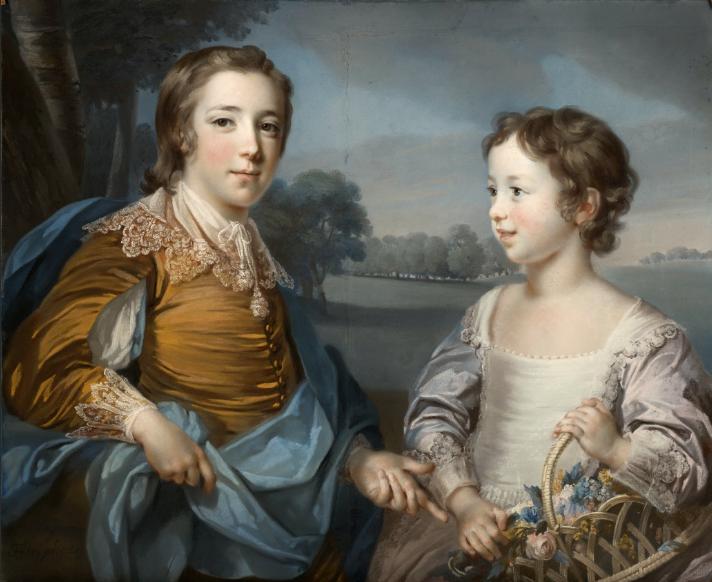
Francis Cotes Paintings: Joseph and John Gulston (1754)

Figure 1.--Cotes painted this pastel portrait of Joseph (1741-86) and his brother John Gulston (1750-64) in 1754. We know very little about their father, Joseph Gulston other than he was rich, a politican and member of Parliament, and had purchased the Ealing Grove estate where this portrait was presumably painted. In this case Joseph's clothing does not show comtemprary styles, but rather 17th cntury cavalier styles as painted by Van Dyck. This was a stylish convention at the time as demonstrated by Gainsboro's Blue boy painted two decades later (1779). Younger brother John in contrast is dressed in contemporary fashions. He wears a formal dress. Often painters provide male props for boys wearing dresses, but Cotes paints John with a wicker basket full of beautiful flowers, a common prop for girls.
|
|
Cotes painted this pastel portrait of Joseph (1741-86) and his brother John Gulston (1750-64) in 1754. We know very little about their father, Joseph Gulston other than he was rich, a politican and member of Parliament, and had purchased the Ealing Grove estate where this portrait was presumably painted. It is near where Ealing Studios would be built. In this case Joseph's clothing does not show comtemprary styles, but rather 17th cntury cabalier styles as painted by Van Dyck. This was a stylish convention at the time as demonstrated by Gainsboro's Blue boy painted two decades later (1779). Younger brother John in contrast is dressed in contemporary fashions. He wears a formal dress. Often painters provide male props for boys wearing dresses, but Cotes paints John with a wicker basket full of beautiful flowers, a common prop for girls. The clothing is depicted in great detail, but what makes this workmaster work is the children faces. Joseph was 13 years old engages the viewer directly wuith his gaze forward, but shows the guarded self-reserve of an older boy. His little brother John was only 4 years old and is depicted very differently. He is shown smiling with the innosence and and unguarded spontaneity of a younger boy and deferring to his older brother. One art historian sees it as an alegory on the passing of childhhod. Cotes has captured this masterfully.
HBC

Navigate the Boys' Historical Clothing Web Site:
[Return to the Main Cotes page]
[Return to the Main English artist page]
[About Us]
[Introduction]
[Activities]
[Biographies]
[Chronology]
[Clothing styles]
[Countries]
[Bibliographies]
[Contributions]
[FAQs]
[Glossaries]
[Images]
[Links]
[Registration]
[Tools]
[Boys' Clothing Home]
Created: 2:13 PM 8/25/2017
Last updated: 2:14 PM 8/25/2017



